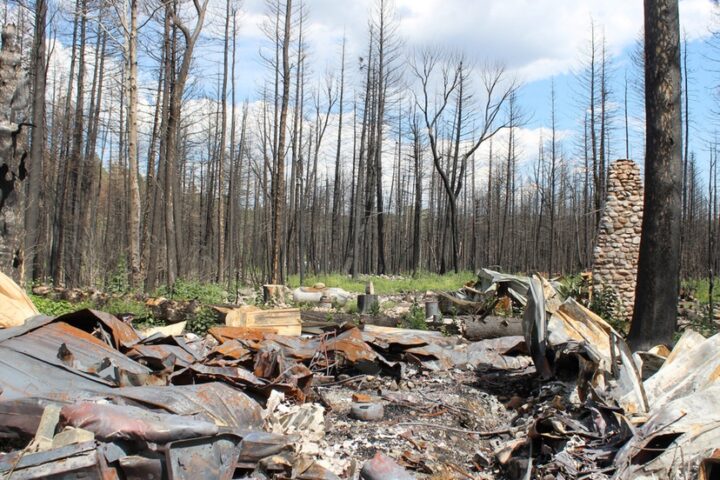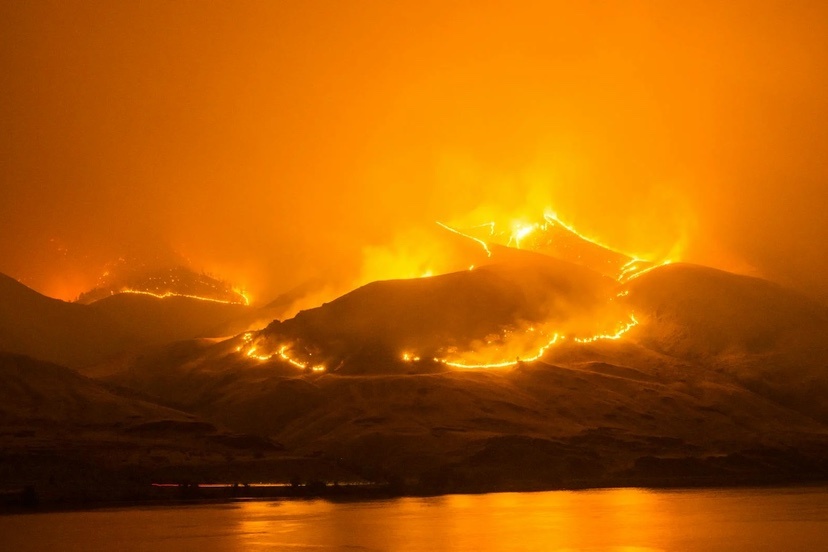This story by Patrick Lohmann was produced in partnership with Source New Mexico, which was a member of ProPublica’s Local Reporting Network in 2023. Read the original article here.
In February 2023, I signed a lease on a dusty studio apartment in Las Vegas, New Mexico, two hours from my apartment in Albuquerque and just outside the burn scar of the largest wildfire in New Mexico history. Based on the railroad ties that served as vigas, my landlord told me my new home had likely been built in the late 1800s.
The rural communities in the mountains of northern New Mexico have long been wary of outsiders. More than a century ago, a band of white-capped marauders on horseback, known as the Gorras Blancas, rode through the countryside to fight back against the predominantly white speculators and railroad barons taking over the land. The Gorras Blancas cut through newly built fences dividing shared pastureland, known as the “ejido,” and burned piles of railroad ties. But they failed to repel the newcomers, who built Victorian homes on what became the town’s well-to-do east side.
My apartment was on the historically Hispanic, lower-income west side. I had moved there at the beginning of a yearlong collaboration between my newsroom, Source New Mexico, and ProPublica to examine the area’s recovery from the fire. The federal government had accidentally triggered the blaze; now the Federal Emergency Management Agency was in charge of distributing checks to compensate people for the government’s mistake. I knew some survivors wouldn’t appreciate being interviewed by someone they perceived as an outsider, even though I’m from New Mexico and have lived here most of my life. For the next year, my job was to gain their trust.
The fire had broadened divisions among residents: between those who had suffered and those who had been spared; between those who had money to rebuild and those who had to wait for a check from FEMA; between those angry at how long it was taking to be paid and those who had taken jobs with FEMA to help process their neighbors’ claims.
I introduced myself to the community in a column published in the weekly newspaper, the Optic, asking people to get in touch. I then set about speaking to anyone willing to open up about the trauma of the disaster, what they saw as a painfully slow release of compensation funds and disaster aid, their fears about losing their culture and their realization that this place had permanently changed. That meant showing up early to public meetings at high school gyms, carrying a stack of business cards and speaking with frustrated survivors until janitors threatened to turn off the lights.
And I worked the phones. After a bit of pestering, a county assessor marked down all the houses she knew had been lost in the fire. I called every property owner, often reaching people who were living far away until they could rebuild or were making do in RVs, friends’ homes, and even, in one case, a tent. Many people were reluctant to talk; some said it was too painful to discuss what they had been through.
One man pretended to speak only Spanish to get me off the phone; I spoke just enough Spanish to convince him to chat with me in English. He taught me a Spanish phrase with a special meaning for those who speak a disappearing dialect unique to the region: “No le busques tres pies del gato sabiendo que tiene quatro.” It means, “Don’t look for three legs on a cat knowing it has four.” He meant it both as a joke and a warning: Tread carefully. He turned out to be friendly, later showing me around his damaged property.

People soon began to recognize me around town. They invited me to sit down and listen in on conversations they were having about the fire that had changed their lives and the long recovery that now consumed their attention. (FEMA officials have said they worked as quickly as they could on a mission that is far different from their typical job of providing short-term disaster aid.)
Many of those conversations reflected the randomness of this disaster, in which some properties were burned to their foundations and others were untouched. Some people had survivors’ guilt; others nursed bitterness. I remember when Juan Ortiz, a rancher, told me that someone with a second home in the area had complained about his own house being spared; the man had hoped to collect the insurance money. Ortiz was devastated over the loss of his home and livelihood. He wished he still had his father’s book collection.
Over those months, I observed the recovery up close. I drove to and from interviews on roads still washed out from the floods that followed the fire. Panicked survivors called me when a small wildfire started in Las Tusas, in an area that had been untouched by the blaze the year before. Like my neighbors, I watched the horizon for storm clouds, wary of the flooding that had become common because the fire-scarred soil couldn’t absorb rainwater. Notices were regularly dropped in my mailbox warning of potential contaminants in the city’s water supply, which had been polluted after the fire.
The many people who generously spoke with us — more than 100 over the course of the year — were vital to our work. The Optic, which has a print circulation of about 3,000, published all our major stories. That’s where most of our sources read them.
Donato Sena, an elderly man who lost his home in the hard-hit village of Rociada, was familiar with my reporting on the fire when I met him. Over the course of several conversations, he told me how grueling life had been in the last year. He and several other survivors had testified in depositions about their losses because they were concerned they would die before they were paid.
Sena had been through four bouts of cancer, which was then in remission. But one day in November, as I was nearing the end of my lease, he collapsed while carrying groceries into his temporary home. The day he died, his wife later told me, he was hopeful he’d be able to move into their new manufactured home on their old property by Christmas.
I heard about his death a day later from a volunteer for a group that donated money to survivors struggling to get by. Over the next few days, four friends of his invited me to his memorial service.
I left my notebook in my car when I arrived at a historic church near the Las Vegas plaza to pay my respects alongside more than 100 others. As Sena’s casket was carried to a hearse, I nodded in acknowledgment to those who followed, people I’d met over the past year: his lawyer, volunteers for the aid group, two others who lost their homes, a columnist for the Optic and various local officials. A few days later, Sena’s widow and their daughter graciously invited me into their home for an interview.
After the funeral, I drove back to my apartment to find a chicken roosting on my patio chair. I walked around the block, seeking her owner. Neighbors told me she might’ve belonged to a guy who recently moved away. I posted to a local Facebook group, and within 15 minutes four folks offered to take her in.
A man who lived up the street arrived in a pickup truck. We chatted about the fire, the sort of small talk that had become part of practically every conversation I had there. He tucked the chicken under his arm, and I got back to work.
Source New Mexico is part of States Newsroom, a nonprofit news network supported by grants and a coalition of donors as a 501c(3) public charity. Source New Mexico maintains editorial independence.

